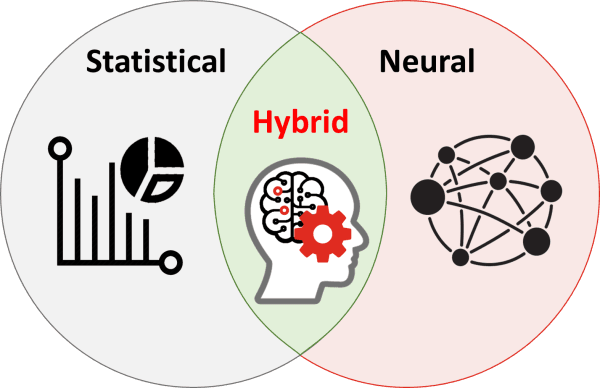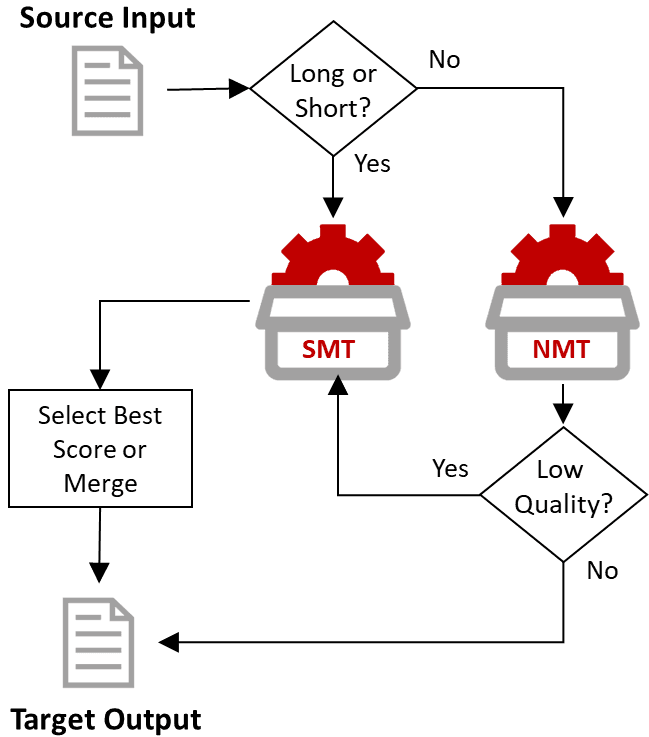Hybrid Neural and Statistical Machine Translation
Different machine translation technologies are more suitable for different scenarios. Language Studio uses multiple translation technologies concurrently and employs a translation quality confidence score to determine the highest quality translation result
Neural Machine Translation (NMT) typically provides more fluent and natural-sounding translations than legacy Statistical Machine Translation (SMT) technology. However, NMT is known to behave unpredictably and produce incorrect results when the content being translated is very different from the content that the machine translation engine was trained on. SMT has also been proven to be more accurate on very short phrases of one or two words in length.
Language Studio calculates a confidence score for every translation and when a score of an NMT translation is below a user-configurable threshold can seamlessly switch to SMT. The best scoring translation of each technology is then selected as the final output.
The resulting translation quality from this simple but effective process is substantially better than using either technology in isolation. In turn, this overcomes one of the major shortcomings of NMT that would normally frustrate editors and linguists tasked to review and refine the machine translation output prior to publishing.


Available as two Platform Editions specifically designed to match different business needs.
- Product Overview
- Machine Translation
- Custom MT Engines
- Industry Domains
- Data Creation Tools
- Clean Data MT Approach
- Ways to Translate
- Hybrid NMT/SMT Engines
- Detailed Features
- Supported Languages
- Document Formats
- Deployment Models
- Data Security & Privacy
- Secure by Design
- Languge Studio Secure Cloud
Hosted by Omniscien - Language Studo Enterprise
On-premises or private cloud - Portal and APIs
Confidence Scores and Translation Workflow
Confidence Scores provide an automated means to determine the quality of a machine translation output. In a Hybrid MT solution, confidence scores measure the quality from a translation source and then determine if the quality is good enough or if an alternative/secondary translation source should be used as a secondary opportunity that may produce a higher quality translation.
Other factors that determine whether to use an alternative translation source include the length of the text. Very short phrases (1-2 words) or very long phrases (50+ words) will typically translate better with SMT than NMT.
The workflow in the diagram shows the logical flow of processing for a standard hybrid NMT/SMT engine. The resulting translation is the combination of the best of both technologies working in unison to produce the highest possible quality output.
Real-World Use Case Example
Confidence scores can also be used in custom workflows to make your own decisions on how to process the output and can be output as part of the XML metadata in TMX and XLIFF files.
A travel customer had millions of travel reviews processed each day. The quality of the content being translated was often low quality as it was user-generated content. Some content was very high-quality also.
Low-quality translations will be created by low-quality input data and sometimes because the MT engine does not have data that was similar in the training data from which the engine was built. The customer used the confidence scores to determine which hotel reviews were high-quality translations. As they had millions of translations each day, they could simply discard the low-quality hotel review translations, irrespective of the cause. Around 30% of the translations were rejected, while the other 70% went live to their website without human review.
This solution required a very small amount (approximately 20 lines of code) of custom scripting built directly into the Language Studio workflow.


